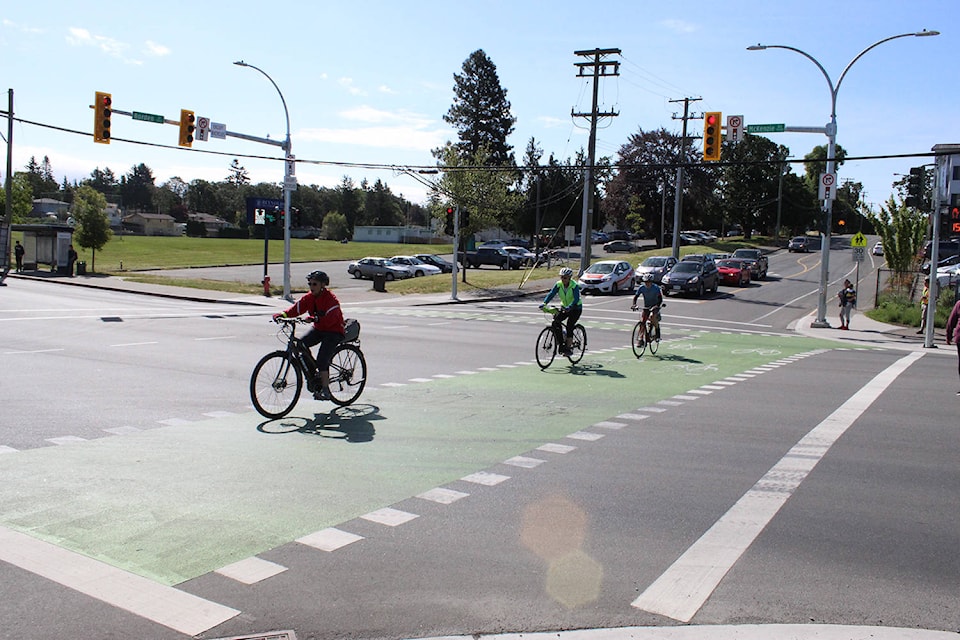As Greater Victoria continues to invest resources into cycling, figures point towards a rising number of crashes, but fewer injured cyclists, with the proviso that the number of cycling-related crashes generally increases during the summer.
ICBC stats show that Saanich was the site of 74 crashes involving cyclists last year, up from 68 in 2016 and above the five-year-average of 69. But the number of injured cyclists in 2017 B��Ԫ������ַ� 44 B��Ԫ������ַ� was actually below the five-year-average of 58, with zero fatalities.
While no figures are available for 2018, both tallies grew Wednesday morning when a cyclist collided with a motorist near Tuscany Village on McKenzie Avenue.
Still, the incident has raised a number of questions, including how safe are Saanich streets for cyclists and what if any seasonal patterns exist when it comes to cycling safety?
B��Ԫ������ַ�Cycling safety on Saanich roads is improving,B��Ԫ������ַ� said Ed Pullman, president of the Greater Victoria Cycling Society. B��Ԫ������ַ�Many projects have been undertaken to improve cycling safety and comfort, and weB��Ԫ������ַ�re excited to see more projects move ahead in future years.B��Ԫ������ַ�
Completed projects in Saanich include among others various improvements along McKenzie Avenue between Cedar Hill Road and Shelbourne. Ongoing projects include improvements along Finnerty Road from McKenzie Avenue to Arbutus Road. Saanich last month also signed off on its
But if the visibility of cyclists and cycling continues to grow on local roads, points of conflicts between cyclists and non-cyclists have also emerged, as evident by this .
Perhaps the most visible location in Saanich where cyclists and motorists find themselves in conflict is on Borden Street at the intersection with McKenzie, where drivers have been using a dedicated bike lane on Borden Street because of its width,
The current summer season could also be shaping dynamics between cyclists and motorists, with more research needed.
Looking at seasonal patterns, Pullman said it is B��Ԫ������ַ�really inevitableB��Ԫ������ַ� that the number of conflicts between cyclists and motorists will increase in the summer months given the large increase in riders on the road.
B��Ԫ������ַ�In terms of statistics, I couldnB��Ԫ������ַ�t give you an idea on how significant the difference is,B��Ԫ������ַ� he said. B��Ԫ������ַ�My hunch is that while there is an increase in collisions [during the summer], itB��Ԫ������ַ�s not proportional to the number of new riders on the road in keeping with the B��Ԫ������ַ�safety in numbersB��Ԫ������ַ� [hypothesis].B��Ԫ������ַ� With riders on the road during the summer, motorists will have an easier time seeing and avoiding conflicts with cyclists, he said.
B��Ԫ������ַ�ThereB��Ԫ������ַ�s also a lot more light which is safer for cyclists,B��Ԫ������ַ� he said. B��Ԫ������ַ�On a whole given the safety in numbers hypothesis it is safer to cycle in the summer months compared to the winter, but inevitably there will be more collisions. Look at the Netherlands. There are more cycling injuries and fatalities in absolute numbers compared to North America, but on a per [kilometre] basis the injury rate is much much lower.B��Ԫ������ַ�
Research from ICBC offers additional evidence in favour of the argument that collisions rise during the summer. According to ICBC, and
Looking at regional figures from ICBC, the City of Victoria recorded 160 crashes involving cyclists, down from 200 in 2016 and 190 in 2015, for a five-year-average of 170. The number of injured cyclists in 2017 reached 110, down from 150 in 2016 and below the five-year-average of 140.
Victoria Police also track collisions involving cyclists, and their figures derived from a different methodology show a historical decline in crashes despite a recent uptick.
But if cycling is getting safer, room for improvement remains.
B��Ԫ������ַ�How can cyclists feel safer?B��Ԫ������ַ� asked Pullman rhetorically. B��Ԫ������ַ�They can write to their government and ask for better cycling infrastructure that separates vehicles and bikes.B��Ԫ������ַ�
Like us on and follow us on



